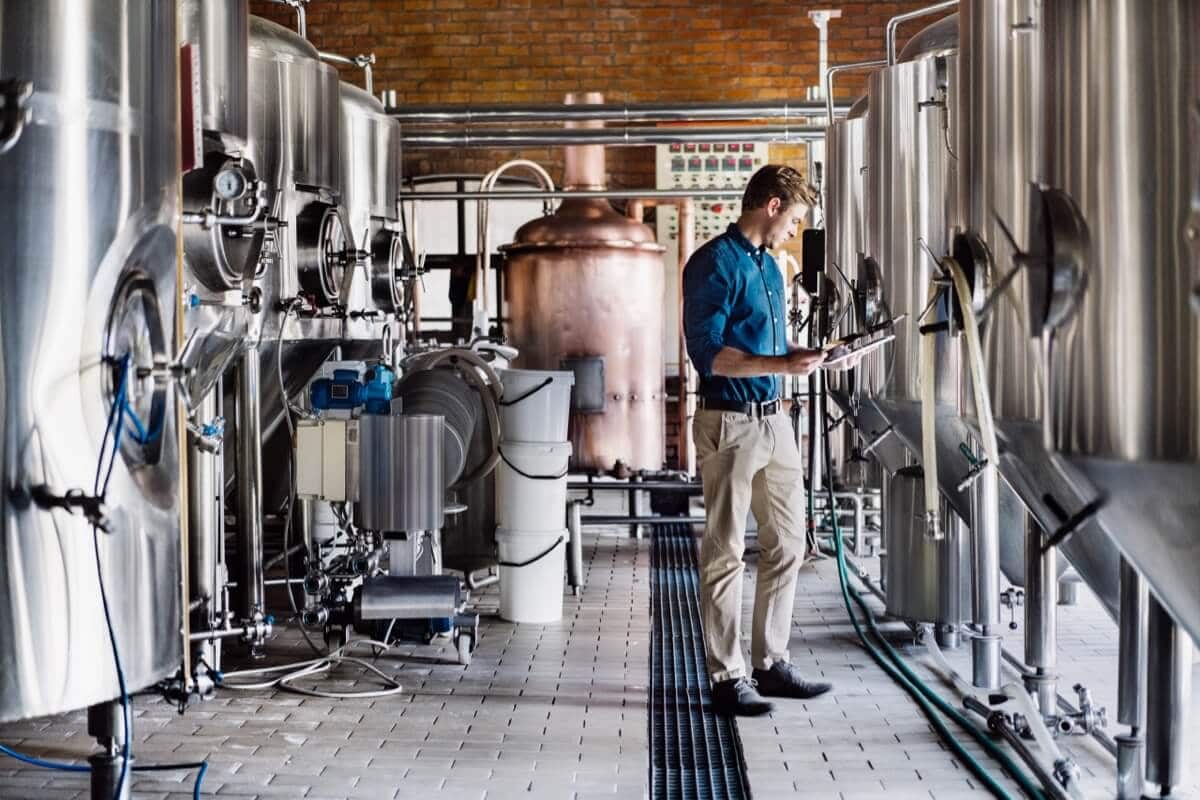
Understanding Brewery Equipment Materials: A Comprehensive Exploration
Brewery equipment is the backbone of the complex and time-honored brewing process, transforming raw materials into the liquid gold we make into beer. This complex process involves a symphony of vessels, pipes, and tanks, each carefully designed and constructed to play a specific role in the alchemical dance of fermentation. The importance of these containers extends beyond their functionality. They are the silent architects that shape the flavor, aroma, and quality of the final beer.
The choice of brewery equipment materials is not just a matter of practicality, but a subtle decision that affects the essence of the beer being produced. Equipment must be able to withstand harsh brewing conditions, resist corrosion, maintain hygiene standards, and help improve the overall brewing experience. Beyond this, these materials profoundly affect the brewing process, affecting taste, aroma, quality, and even the safety of the final product. The choice of materials becomes an art form that defines the essence of the beer brewing process.
This article provides a comprehensive look at the many materials used in brewery equipment. From the rugged stainless steel to the traditional charm of copper, the lightweight efficiency of aluminum, the aesthetic appeal of glass, the versatility of plastic, and the nostalgic revival of wood, each material brings its own story to the brewing story.
Comprehensive Exploration
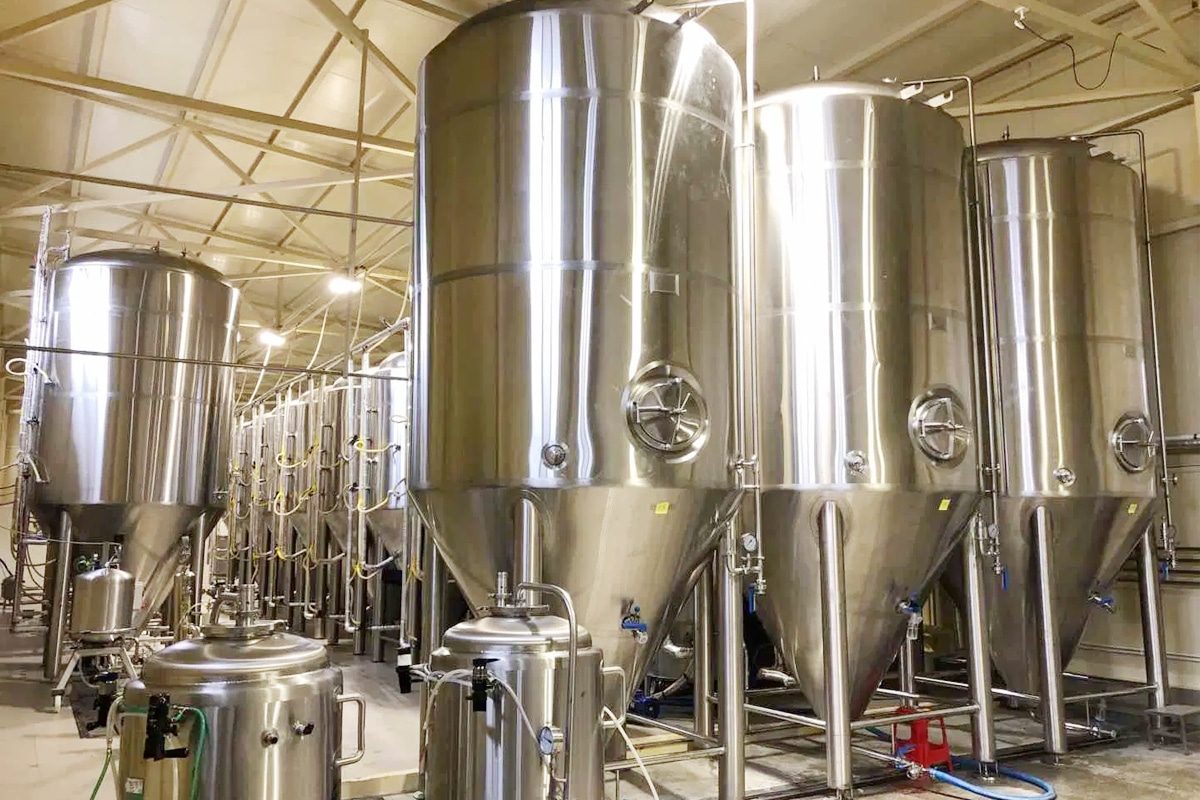
Stainless Steel
Introduction to Stainless Steel
Stainless steel is the most common choice among brewery equipment materials. Its ubiquity is due to its combination of resilience, hygiene, and structural integrity, which makes it a cornerstone of the art of brewing. Stainless steel is an alloy crafted to resist corrosion and staining while maintaining an impeccably clean surface. It is an alloy composed primarily of iron, chromium, and nickel and is known for its resistance to corrosion and rust.
Stainless Steel Properties
- Corrosion Resistance: The defining property of stainless steel in brewery equipment is its excellent corrosion resistance. The chromium in the alloy forms a passive oxide layer on the surface, protecting it from the corrosive elements present during the brewing process. This ensures the purity of your beer and the longevity of your equipment.
- Durability: Stainless steel offers impressive durability and can withstand the harsh conditions of a brewery environment. This robustness allows stainless steel to withstand frequent cleaning, temperature fluctuations and the mechanical stress of the brewing process.
Types of Stainless Steel Used in Brewery Equipment
- 304 Stainless Steel: This austenitic stainless steel is popular in beer equipment because of its corrosion resistance, ease of fabrication, and affordability. It is typically used in brewery applications where corrosion resistance is not critical.
- 316 Stainless Steel: For applications that require greater corrosion resistance, especially where acidic or brine brewing ingredients are present, 316 stainless steel can come into play. With the addition of additional elements such as molybdenum, it provides superior protection against corrosion, making it ideal for critical brewing components.
Application in Brewery Equipment
- Brewhouse: The stainless steel brewhouse is the core of the brewing process and needs to withstand high temperatures during the mashing and boiling processes. The alloy’s thermal conductivity ensures efficient heat transfer, aiding precise temperature control. In addition, the corrosion resistance of stainless steel ensures a hygienic environment during the initial stages of beer production.
- Fermentation Tank: The controlled environment of fermenters requires materials to maintain purity and prevent contamination. The non-reactivity of stainless steel fermenters provides a sterile environment for yeast to proliferate, providing an ideal container for yeast to work its magic without affecting beer quality.
- Bright Tank: As the beer matures and conditions, the stainless steel bright tank maintains a pristine environment during the final stages of the brewing process. The durability of stainless steel ensures that the vessel can withstand long periods of brewing.
Advantages of Stainless Steel
- Hygienic: Stainless steel’s smooth, non-porous surface facilitates cleaning and prevents bacterial growth, ensuring beer purity.
- Corrosion Resistance: The corrosion resistance of the alloy ensures the integrity of your equipment and the purity of your beer.
- Versatility: Stainless steel’s adaptability makes it suitable for a variety of brewing equipment applications, from kettles to fermenters.
- Durability: Stainless steel equipment is built to last, able to withstand rigorous brewing processes and frequent cleaning regimes, and extend the life of the equipment.
Disadvantages of Stainless Steel
- Cost: Higher grades of stainless steel may be more expensive, affecting the initial investment.
- Metallic Flavor Potential: In some cases, stainless steel may impart metallic flavors to beer, especially if the equipment is not adequately passivated or maintained.
- Weight: The density of stainless steel affects the overall weight of the equipment, affecting the mobility and maneuverability of larger brewing vessels.
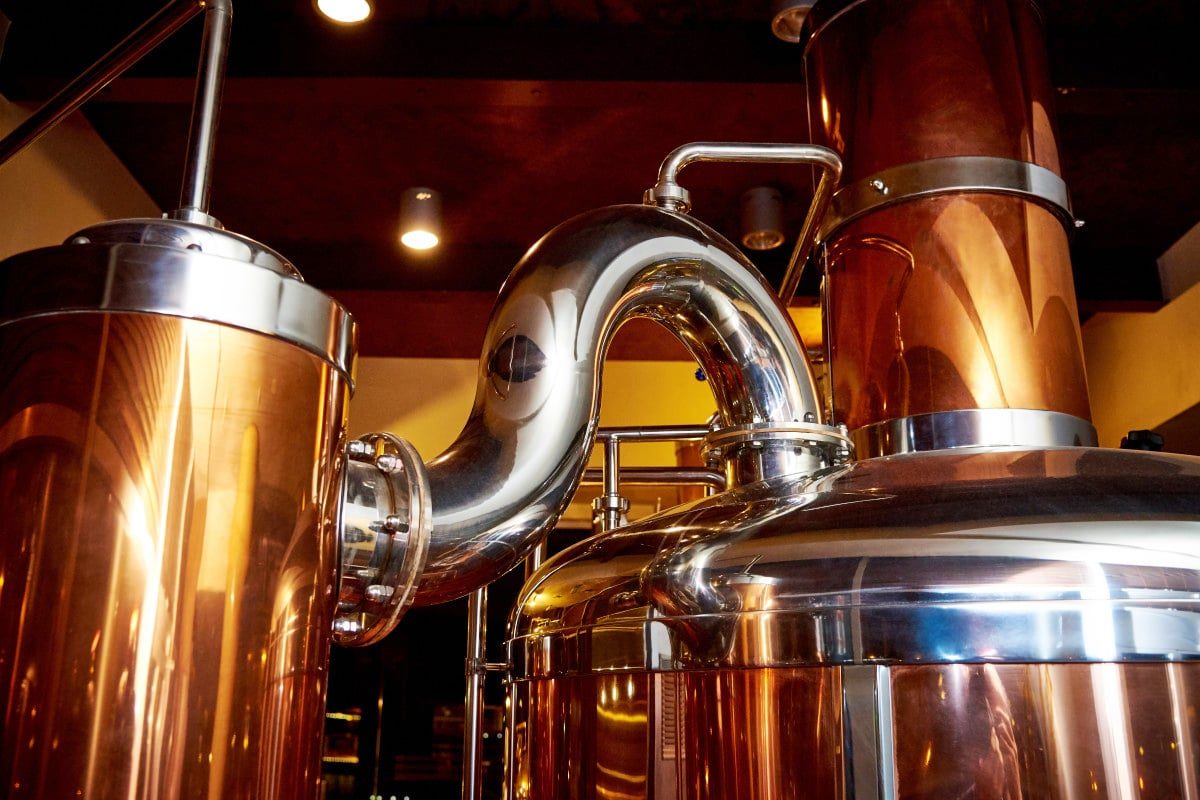
Copper
Historical Uses of Copper in Brewing
Copper’s legacy in brewing stretches back throughout history, resonating with tradition and craftsmanship. It has a place in ancient brewing practices across cultures, embodying not only functional significance but also cultural reverence for its mystique and brewing efficacy.
Unique Properties of Copper
- Thermal Conductivity: Copper has excellent thermal conductivity, helping to distribute heat quickly and evenly during the brewing process, making it a valuable material for brewery equipment. During the brewing process, copper kettles promote rapid temperature changes, which are essential for the enzymatic reactions during mashing and boiling.
- Antimicrobial properties: The inherent antimicrobial properties make copper surfaces inhospitable to the growth of bacteria, mold, and other microorganisms and therefore can be used as a self-disinfecting surface. This property inhibits the growth of bacteria and other microorganisms, helping to create a cleaner, more hygienic brewing environment.
Application in Modern Brewery Equipment
- Brewhouse: The copper brewhouse echoes tradition while taking into account functionality. Rapid and even heat distribution provides an environment conducive to precise temperature control and efficient heat transfer during the mashing and boiling processes, thereby affecting the final flavor profile of the beer.
- Fermentation Tanks: In modern breweries, fermentation tanks made of copper not only contribute to aesthetics but also contribute to a natural antimicrobial environment. This helps maintain a clean and uncontaminated space for the yeast to work its transformative magic.
Copper VS Stainless Steel Comparison
- Aesthetic Appeal: With its warm tones and timeless charm, copper brings a touch of elegance to brewery equipment. Its aesthetic appeal is often a deliberate choice by a brewery to create a visually unique space.
- Flavor Impact: Unlike stainless steel, copper can have a subtle impact on the flavor of your beer. This can create unique flavors and complexities that influence the character of the final beer, making it preferred for certain beer styles.
- Maintenance And Durability: Copper, while offering unique advantages, requires vigilant maintenance to prevent corrosion and ensure longevity, in contrast to stainless steel’s resilience and ease of maintenance.
Restrictions And Precautions When Using Copper
- Corrosion Susceptibility: Although copper itself is antimicrobial, it can easily corrode over time when exposed to certain acidic or alkaline solutions. Regular maintenance may therefore be required to maintain its functionality and appearance.
- Cost And Availability: The initial investment and scarcity of copper as a brewing material compared to stainless steel creates financial and accessibility challenges for brewers considering including it in their equipment lineups.
- Reactive Properties: Copper can react with certain substances, possibly affecting beer. Brewers must consider copper’s compatibility with specific brewing ingredients.
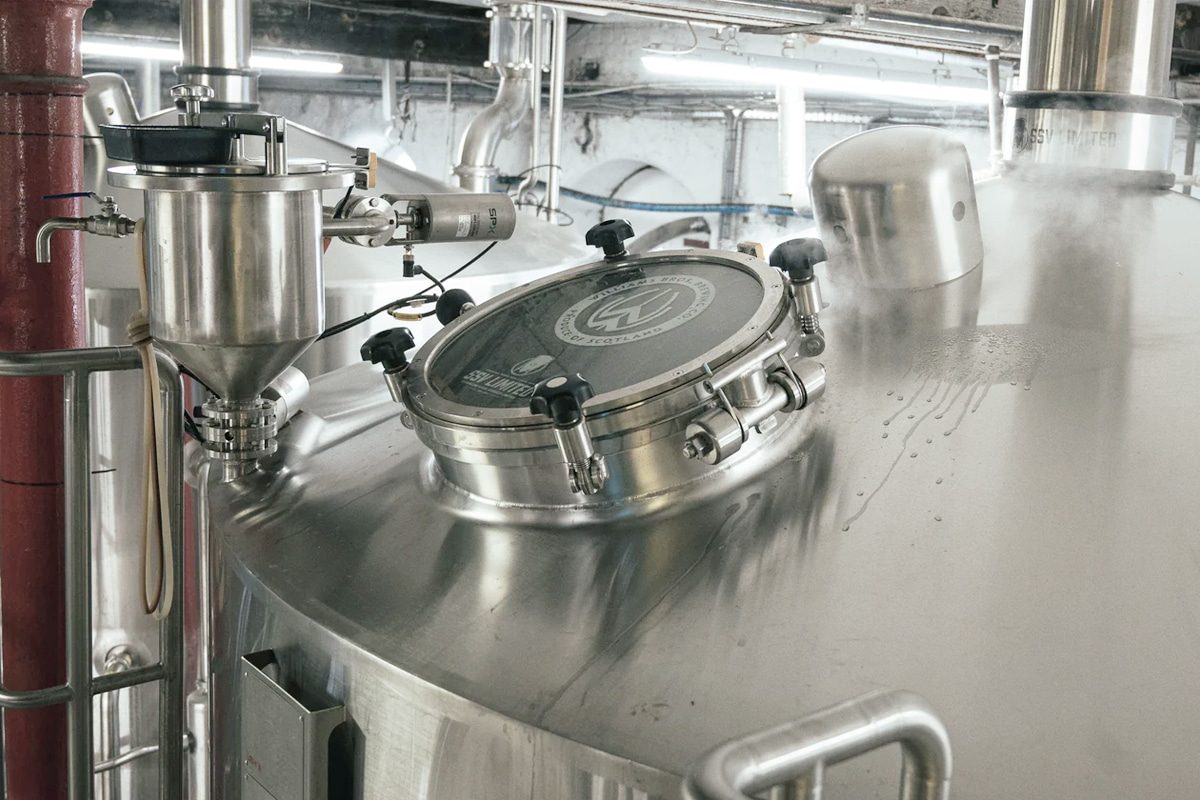
Aluminum
Restrictions And Precautions When Using Copper
Aluminum is characterized by low density and is a very lightweight material. This feature makes it an attractive option for brewery equipment where mobility and ease of operation are crucial, especially in small breweries. In addition, aluminum has excellent thermal conductivity, ensuring efficient heat transfer in various brewing processes. This quality makes it suitable for applications requiring precise temperature control, such as smaller kettles or specific brewing vessels.
Application in Brewery Equipment
- Smaller Brewhouses: Due to its lightweight properties, aluminum is often used to create smaller brewhouses, especially in small breweries or experimental batches. These brewhouses provide flexibility and ease of operation during the brewing process, allowing brewers to experiment with different recipes and brewing techniques without the logistical challenges of heavier materials.
- Containers: Aluminum containers are used in every aspect of brewery operations. From storing and transporting raw materials like hops to being used as a vessel for specific brewing processes, aluminum’s versatility meets a range of needs within the brewing workflow.
Advantage
- Lightweight Construction: The main advantage of aluminum is its weight. Brewery equipment made of aluminum is significantly lighter than brewery equipment made of materials such as stainless steel or copper. This feature facilitates easier handling, maneuverability, and overall mobility within the brewery.
- Cost-Effective Solution: Affordability is a significant advantage of aluminum, which is especially beneficial for small brewing equipment or brewing equipment on a limited budget. Aluminum offers a cost-effective alternative without compromising functionality in some applications.
Challenges And Limitations
- Corrosion Susceptibility: While aluminum does have some degree of corrosion resistance, it is not as strong as stainless steel. Exposure to certain conditions, especially those involving acidic or alkaline substances, can cause corrosion over time. Brewers must carefully consider aluminum’s compatibility with their brewing processes and ingredients.
- Reactivity: Aluminum’s reactivity with certain substances, especially acidic components, raises concerns about flavor effects and potential reactions that may alter beer characteristics. Brewers need to carefully consider the compatibility of aluminum with their brewing ingredients.
- Durability: Aluminum may be more susceptible to dents and scratches than stainless steel. This aspect requires brewers to handle equipment with care to ensure longevity and prevent structural damage.
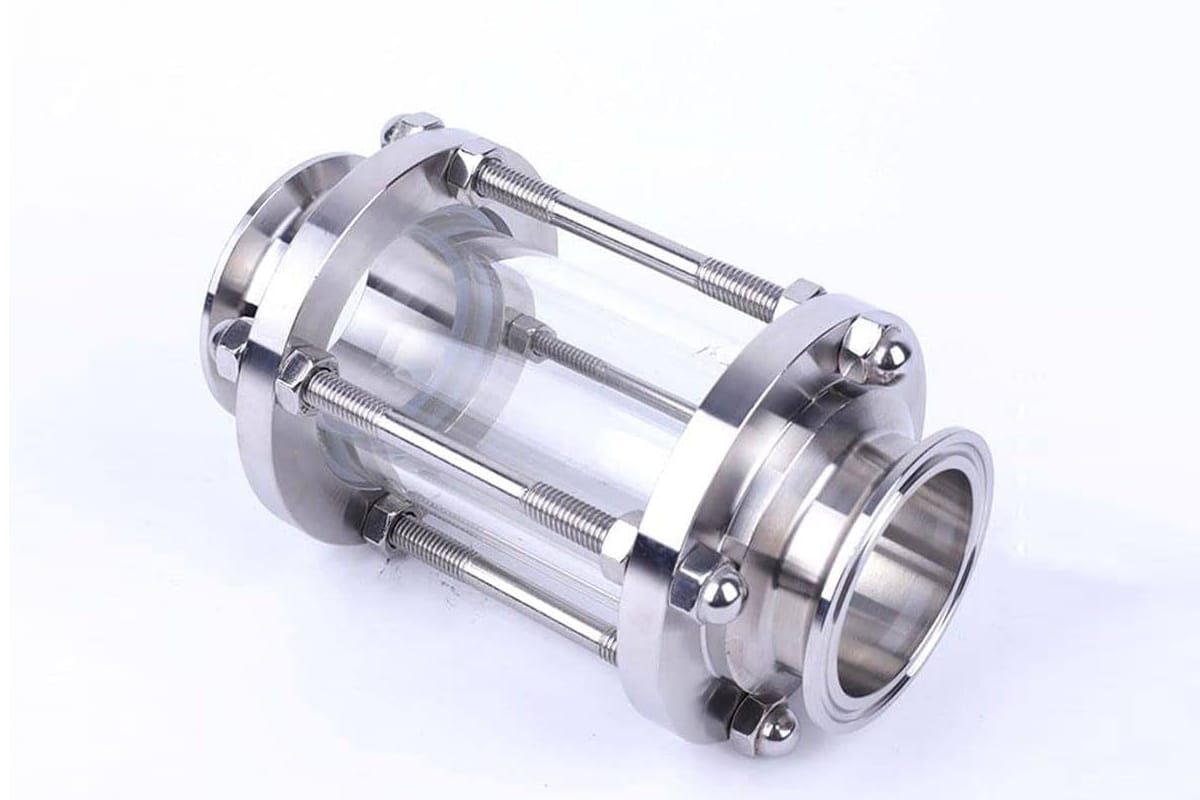
Glass
Use of Glass in Brewery Equipment
Prized for its transparency and aesthetics, glass finds its place in certain brewery equipment, primarily in fermentation and conditioning vessels. Its elegant visuals add a unique dimension to the brewing environment, allowing brewers and consumers to observe the brewing process.
Application
- Fermentation Tank: Glass fermentation tanks provide a clear window into the fermentation process, allowing brewers to monitor yeast activity and fermentation progress. This transparency aids in quality control and ensures a visually engaging experience.
- Bright Tank: During the conditioning stages of beer maturation and carbonation, the glass container maintains its role, providing a beautiful touch while allowing visual inspection of the beer’s clarity and carbonation levels.
Advantage
- Aesthetic Appeal: The main advantage of glass is its aesthetic appeal. Breweries using glass vessels create an immersive experience, allowing both customers and brewers to immerse themselves in the visual spectacle of brewing. The transparent nature of the glass enhances the overall ambiance of the brewery.
Handling And Maintenance Challenges
- Fragility: Glass is fragile by nature. Handling glass containers requires care and attention to prevent breakage or damage, bringing an element of refinement to the brewing process. Brewers must be careful during cleaning, transportation, and any other handling to avoid potential accidents.
- Maintenance Notes: Maintaining the pristine appearance of glass fixtures requires regular, meticulous cleaning. While glass’s nonporous surface resists bacterial growth, maintaining its aesthetics requires attention to detail and consistent cleaning practices. Additionally, glass scratches easily and can harbor bacteria and affect the quality of your beer if not cleaned carefully.
Comparison With Other Materials
- Compared to Stainless Steel: Glass has clear aesthetic advantages compared to stainless steel. While stainless steel offers durability and ease of maintenance, glass appeals to those who value the visual impact of their brew. The choice between the two usually depends on the desired atmosphere within the brewery and the emphasis on showcasing the brewing process.
- Compared to Aluminum and Copper: Compared to aluminum and copper, which give beer its unique characteristics, glass is inert and does not impart additional flavor. Its primary role is visual, making it a neutral choice for brewers who care about appearance without compromising on flavor.
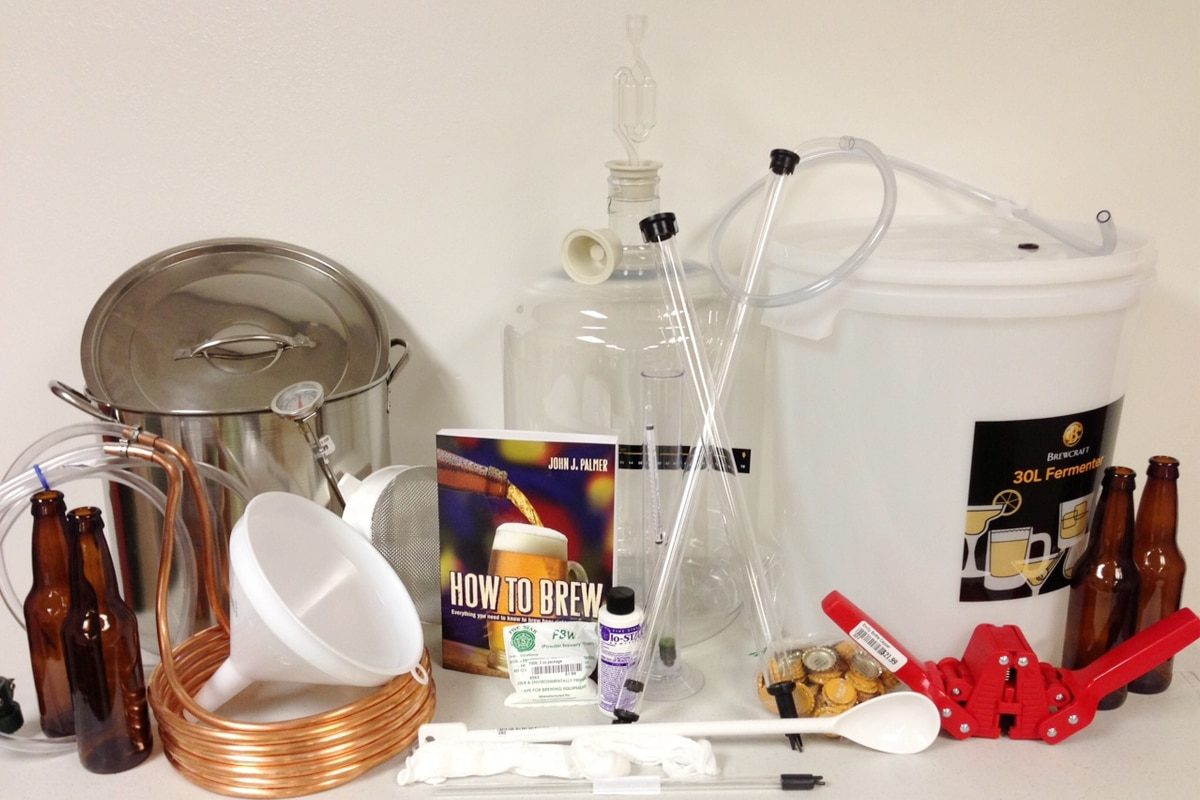
Plastic
Food Grade Plastic
- Polyethylene (PE): Polyethylene is a versatile thermoplastic that is widely used in brewery equipment due to its flexibility, toughness, and chemical resistance. It comes in many forms, including high-density polyethylene (HDPE) and low-density polyethylene (LDPE).
- Polypropylene (PP): Polypropylene is another popular food-grade plastic valued for its strength, heat resistance, and suitability for contact with consumables. It is often chosen for its high-temperature resistance and chemical stability.
Application in Brewery Equipment
- Hoses: Polyethylene and polypropylene hoses play a vital role in breweries, helping in the transfer of liquids such as wort and beer between beer vessels. Its flexibility simplifies the complex web of connections in the brewing process.
- Gaskets And Seals: Both polyethylene and polypropylene are used to produce gaskets and seals for beer equipment. These components ensure an air- and water-tight seal, preventing leaks during the brewing process. Their food-grade status ensures they won’t introduce contaminants into your beer.
- Fermentation Vessels: Some fermentation vessels, especially those found in home brewing or experimental setups, may use food-grade plastic materials. These vessels offer a cost-effective alternative and are easier to operate than larger glass or stainless steel fermentation tank
Advantage
- Cost-Effectiveness: One of the main advantages of using food-grade plastics in brewery equipment is its cost-effectiveness. This affordability makes them particularly attractive to small breweries, home breweries, or breweries on a budget.
- Flexibility: Polyethylene and polypropylene are highly flexible and can be easily molded into a variety of shapes and sizes. This adaptability is advantageous in crafting hoses, gaskets, and other components to suit specific brewing needs.
- Chemical Resistance: Both plastics are resistant to a range of chemicals used in the brewing process. This resistance ensures that the plastic retains its structural integrity and functionality without being adversely affected by brewing ingredients.
Concerns And Limitations
- Oxygen Permeability: A noteworthy issue with food-grade plastics is their potential for oxygen permeability, especially when stored or conditioned for long periods. This can impact the flavor and shelf life of beer, requiring brewers to carefully consider the duration and conditions under which the plastic is used.
- Potential Off-Flavors: Although some food-grade plastics are chemically resistant, some food-grade plastics may impart subtle off-flavors to beer over time. Brewers need to evaluate material composition and its impact on the final product. Additionally, food-grade plastics can impart an unpleasant taste to beer if not adequately cleaned.
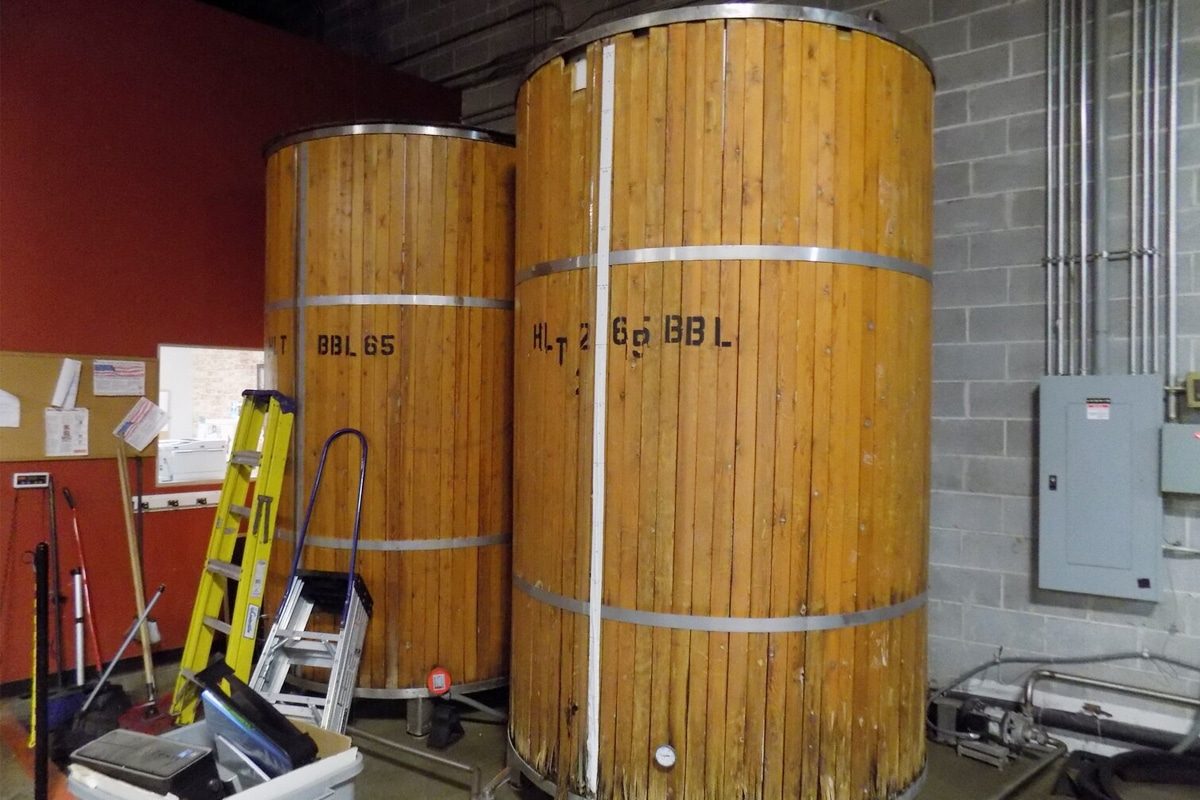
Wood
The Resurgence of Wood in Brewing
- Historical Significance: Wood has a long history in brewing, and traditional wooden vessels are the cornerstone of many brewing traditions. In recent years, there has been a significant resurgence of interest in the use of wood in brewery equipment, driven by the desire to infuse beer with unique flavors and aromas.
- Craft Beer Impact: Craft brewers, in particular, have begun using wooden vessels, reviving age-old practices, and pushing the boundaries of flavor experimentation. This revival is not only a nod to tradition but also a reimagining of how wood contributes to the complexity of modern beer.
Application
- Barrels for Aging Beer: Wooden barrels (usually oak, but also varieties such as cedar or cherry) have become the iconic vessel for aging beer. Brewers use these barrels to give the beer its unique flavor, aroma, and character as it matures. The porous nature of the wood allows for gradual oxidation and interaction with the barrel, thus aiding in the evolution of the beer.
Wood's Flavor Contribution
- Complexity And Depth: Wood aging brings a range of flavors to the beer, from vanilla and caramel to woody and tannic notes. The porous nature of wood allows the beer to interact with the compounds present in the wood, creating nuanced, layered flavors.
- Tannins And Aromatics: Tannins in wood can add structure to beer, affect mouthfeel, and impart subtle astringency. In addition, the aromatic compounds present in the wood can impart a pleasant smell, enriching the olfactory experience of the beer.
Suitability For Specific Beer Styles And Flavors
- Barrel-Aged Beers: Certain types of beer, such as stouts, porters, sours, and strong ales, benefit greatly from aging in wooden barrels. The aging process of wood can enhance these styles by giving it a subtle flavor of its inherent character.
- Enhancement of Specific Flavors: Wood can accentuate specific flavors in a beer, enhancing fruity, spicy, or malty flavors depending on the type of wood and its previous use. Winemakers often experiment with different wood species to achieve the desired flavor profile.
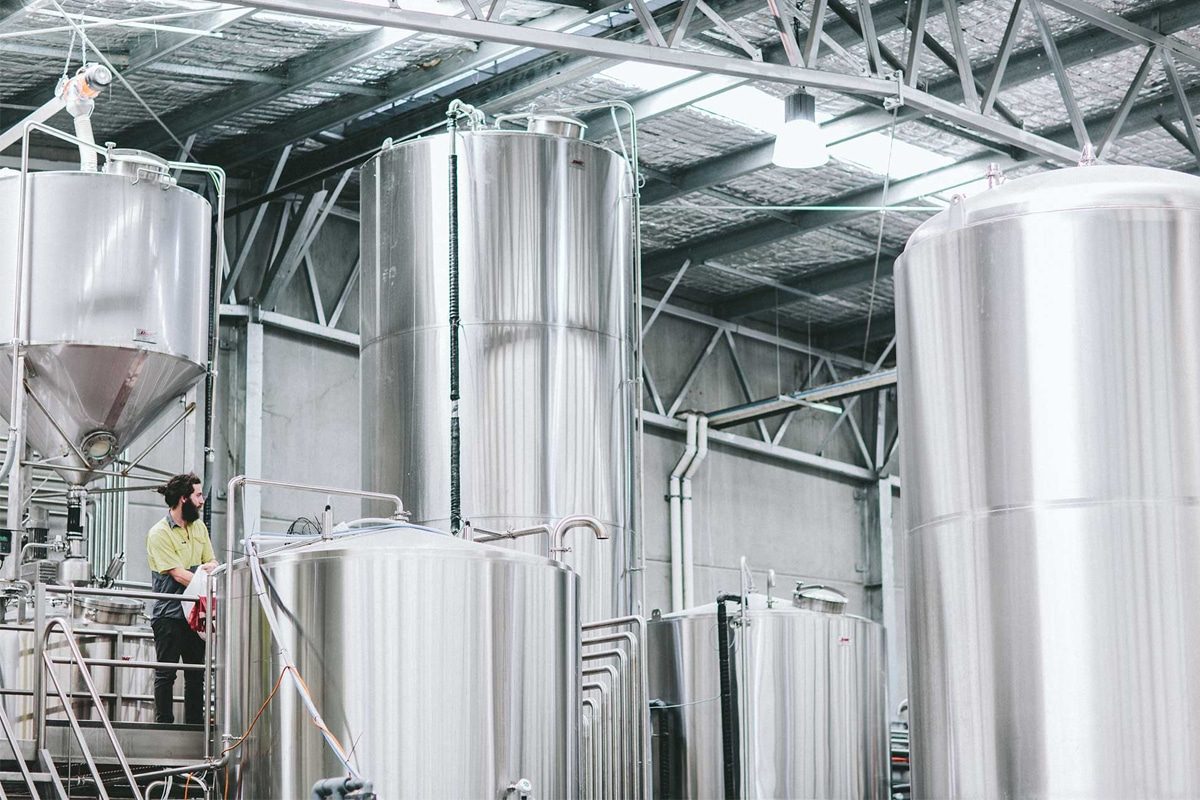
Future Trends And Innovations in Brewery Equipment Materials
Emerging Materials in Brewery Equipment
- Nanocoatings: The integration of nanomaterials such as nanoparticles or nanocomposites holds great promise in brewery equipment. These coatings are typically applied to stainless steel or other traditional materials to enhance their surface properties, improve resistance to corrosion and bacterial growth, and make cleaning easier.
- Sustainable Composites: Breweries are increasingly exploring sustainable composites made from materials such as recycled plastics, plant-based polymers, and even biocomposites. These materials align with the industry’s growing focus on sustainability and reducing environmental impact.
- Smart Materials: Material innovations are incorporating smart technologies, such as sensors and monitoring systems embedded in devices. These materials provide real-time data on temperature, pressure, and other critical brewing parameters, allowing for precise control and monitoring.
Advances in Materials Technology
- 3D Printing: Advances in 3D printing technology are making their way into brewery equipment manufacturing. This allows the creation of complex custom designs, optimizing equipment for a specific brewing process, or achieving unique shapes that were previously difficult to produce.
- Composites Research: Continuing research into composite materials, which combine the strengths of different elements, is pushing the boundaries of what is possible. These materials offer a balance of properties, such as the strength of metal with the flexibility of plastic, opening up new possibilities for brewery equipment.
- Energy-Efficient Material Engineering: Materials designed for improved thermal conductivity and insulation help make brewing energy efficient. This includes innovations in insulation materials for fermenters and kettles, reducing energy consumption at all stages of brewing.
The Impact of Materials on Brewing Technology And Flavor
- Precise Control of The Brewing Process: Advances in smart materials and materials technology facilitate precise control of the brewing process. Emerging materials with enhanced thermal conductivity and customized properties allow brewers to precisely control brewing temperatures, thereby increasing the consistency and quality of the final product.
- Flavor Modulation: Innovative materials can influence flavor modulation by controlling oxygen exposure, promoting the extraction of specific compounds, and modulating the interaction between the beer and its container to create subtle flavor profiles.
- Efficiency And Sustainability: Materials designed for sustainability not only reduce environmental impact but also promote a more efficient brewing process. Environmentally friendly materials help conserve resources and reduce waste, align with the industry’s sustainability goals, and attract environmentally conscious consumers.
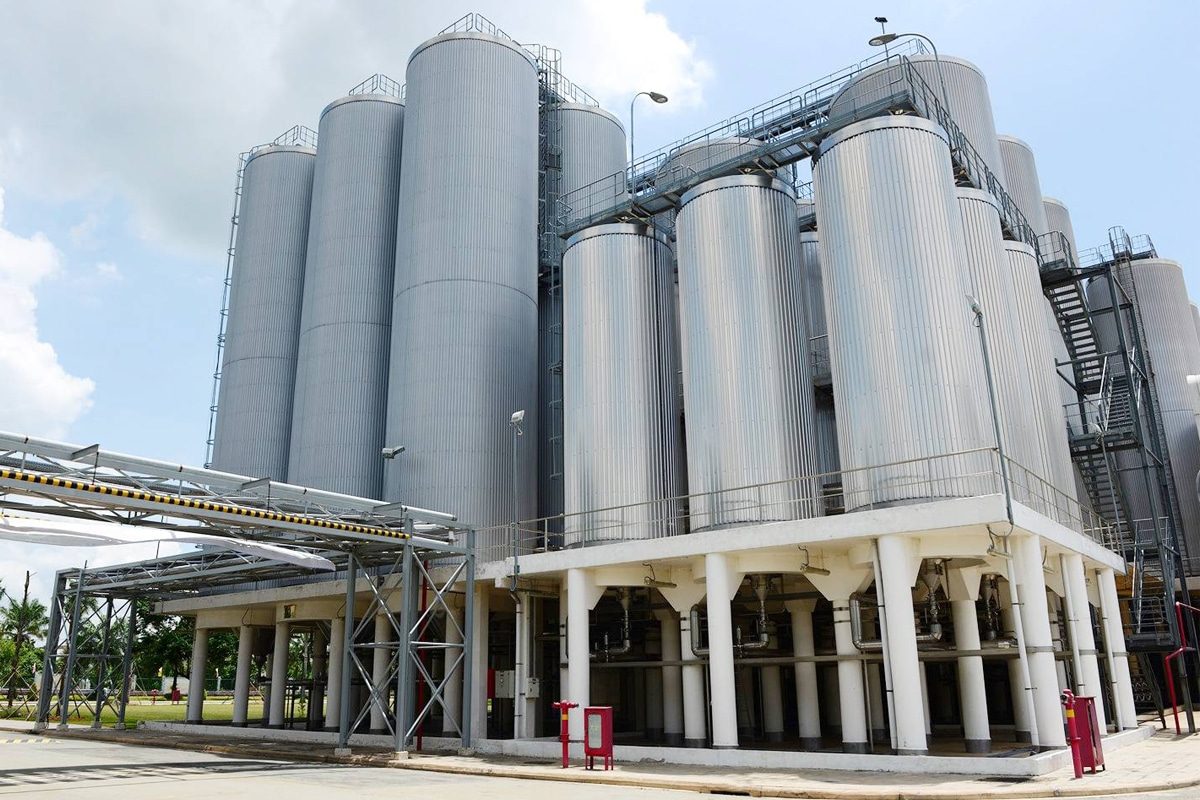
Summarize
In the symphony of brewing, the choice of materials for beer equipment achieves a harmonious blend of tradition, innovation, and functionality. Stainless steel offers unwavering strength, ensuring durability and cleanliness, while copper tells the story of brewing tradition. Aluminum and plastic bring flexibility and economy, glass adds visual elegance, and the revival of wood brings subtle flavor and a nod to bygone eras.
The importance of ingredient selection in the brewing process goes beyond practicality, It’s an orchestration that affects every aspect of the brewing process. From mashing to conditioning, the materials chosen are integral to the flavor, aroma, and overall character of the beer. Brewers, as artists, explore this realm, choosing materials that will not only withstand the rigors of the brewing process but also contribute to the subtle artistry of their craft.
The evolution of brewery equipment materials is a dynamic narrative that reflects the brewing industry’s eternal dance between tradition and innovation. When we look at stainless steel, copper, aluminum, glass, plastic, and wood, we also see possibilities that have yet to be explored. Future-proof sustainability, precision, and materials that not only stand the test of time but redefine the boundaries of brewing.
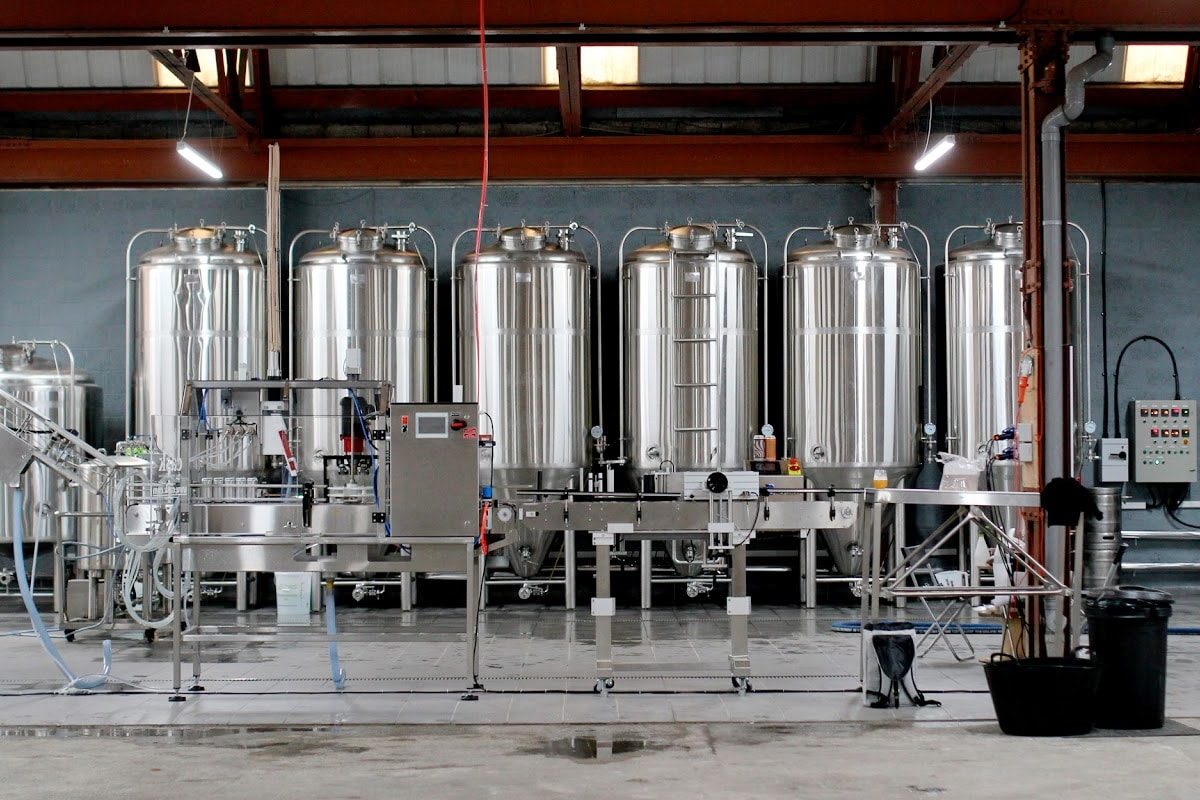
Get A Turnkey Solution For Your Brewery
Brewing is a harmonious combination of art and science, and much depends on the choice of beer equipment materials. From the brewhouse that initiates the process to the vessels that nurture fermentation, each material makes a unique contribution to the quality, flavor, and integrity of the final brew. At ZYB Craft, we understand the critical role materials play in brewing excellence, offering comprehensive turnkey solutions for aspiring brewers and established brewers alike. Our expertise ensures material selection matches your brewing vision. From consultation to installation, we offer a full range of services to create a seamless brewing journey for our customers. We invite you to ask us for complete turnkey solutions that blend craftsmanship, innovation, and excellence to create your winemaking success story.



